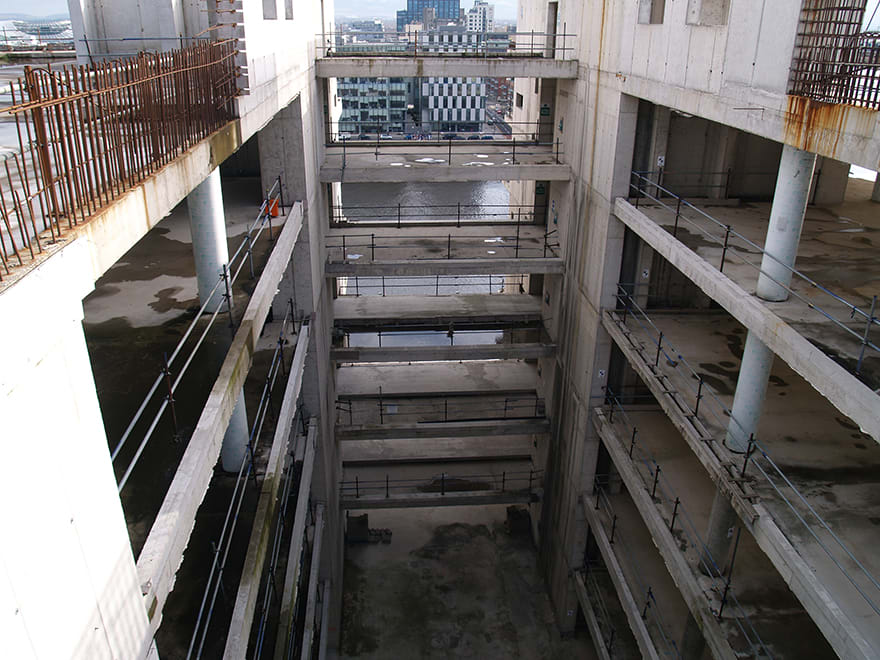- Client: Central Bank of Ireland
- Lead Contractor: Gardiner & Theobald
- BIM Tools: Faro Focus 3D laser scanner, Autodesk Revit
At the height of the Irish property boom the Anglo Irish Bank began building a new eight-storey office block on a highly visible site on the north bank of the River Liffey, in central Dublin. However, construction came to an abrupt halt in 2009 as the bank, which was heavily exposed to property lending, ran into financial issues and was eventually nationalised by the Irish government.
After five years the partially complete frame was purchased by the Central Bank of Ireland, with the intention of creating a new headquarters for itself. However, before design work on the new building could begin the design team needed to understand the state of the incomplete building.
Carlow-based Coastway Surveys was employed by quantity surveyor Gardiner & Theobald to provide a detailed as-built 3D Revit model of the unfinished concrete structural frame. This model was then supplied to architect Henry J Lyons and facade and structural engineer Aecom for design and planning purposes.
Read more
Dublin recladding project symbolises Irish recovery
Coastway faced unique safety issues in creating the scan of the building’s shell. Enda Nolan, managing director of Coastway Surveys, explains: “The main challenges experienced in scanning the building included weather conditions, the building is open on all sides and exposed to the full force of Dublin Bay, it was scanned in March, we had all weather conditions thrown at us, including snow.”
Access was a problem as several areas had been hoarded off to avoid vandalism, temporary works were still being put in place and certain areas were flooded. Harnesses had to be worn by surveyors at all times as edge protection had been installed years earlier and could not be relied upon and algae had built up on floor surfaces making conditions slippery under foot.

Harnesses had to be worn by surveyors at all times as edge protection had been installed years earlier and could not be relied upon
Nolan says live cables on site were also a safety concern: “We treated all cables as live at all times as many had deteriorated from exposure to the conditions, the scaffolding was live on the seventh floor, confirming our safety precautions.”
The Coastway team carried out a 3D laser scan survey of all 11 floors using the Faro Focus 3D laser scanner to create a sub-10mm scan within 10 days.
Using the point cloud data captured, Coastway modelled each floor slab and provided a grid of levels at 1m x 1m centres to facilitate the fit-out of raised floors and false ceilings. The lift and stair cores were at different stages of completion so posed access issues, which were overcome using inverted scanners and extended booms.
Coastway also took on the task of tracing all drainage on site and in the building. All pipes were jetted to aid the production of a drainage condition report.
In addition, a ground-penetrating radar (GPR) survey was carried out to locate buried services and piles and a 3D walkthrough was created.
Nolan continues: “We also provided a 3D walk through of the building allowing designers to walk through the point cloud to take measurements and check the verticality of columns which varied between floors – this became an issue when modelling as the software tries to straighten objects which are not perfectly aligned when built, such as walls and columns.”
The building is open on all sides and exposed to the full force of Dublin Bay. It was scanned in March, we had all weather conditions thrown at us, including snow.– Enda Nolan, managing director, Coastway Surveys
Comments
Comments are closed.












The story is a testament to the competence of the teams doing the work and the companies involved but I think this building should be destroyed and the rubble used for a sea wall or something. It should not be completed.
This dilapidated shell is a symbol of the Celtic Tiger crassness and hubris.
By purchasing it, the Central Bank exposed itself as the tool of the monied elite. A disgrace in itself.
Now more taxpayers’ money is being thrown at what – at best – is likely to become a mediocre, mid range building with an inescapable, really bad provenance.
Like the Irish Central Bank, it is not fit for purpose.
Therefore I have four suggestions.
First – demolish this ruin.
Second – demolish the dysfunctional Central Bank
Third – establish a competent Central Bank serving the people of Ireland, who pay for it
Fourth – design and build an iconic new building that reflects this.